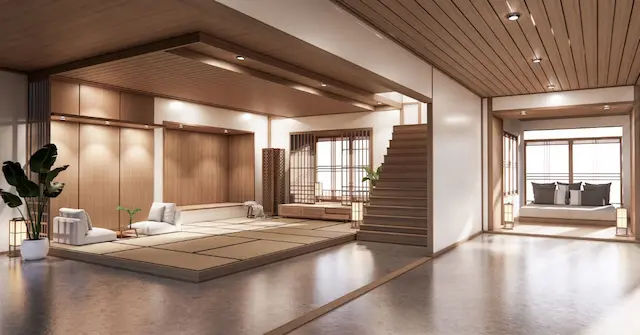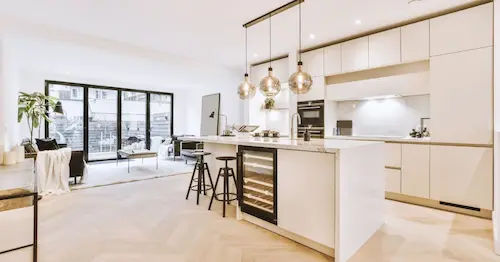Japanese Interior Design Singapore

Japanese interior design style has always been synonymous with tranquility, balance, and simplicity. In Singapore, interior designers have been successful in adopting and blending this foreign concept with local flavors, resulting in uniquely appealing spaces.
The best japanese interior design Singapore ideas are Lots of wood in a minimal, open setting, Engawa-inspired extended living area, Tatami flooring in the bedroom, Meditating room with neutral walls, and Shoji screen opening up to lots of greenery.
This marriage of styles often incorporates elements of Japanese minimalism, embodying the principle of ‘less is more’, and is known as the ‘Japandi’ style. This guide will delve into ten of the best Japanese design ideas in Singapore, highlighting how interior architecture interacts with these design elements to create serene, functional spaces that are truly a class apart.
Quick Summary
- The best japanese interior design Singapore ideas are Lots of wood in a minimal, open setting, Engawa-inspired extended living area, Tatami flooring in the bedroom, Meditating room with neutral walls, and Shoji screen opening up to lots of greenery.
- When choosing Japanese Interior Design in Singapore, it’s crucial to consider the authenticity of design elements, your personal aesthetic preference, the functionality of the space, and the integration of natural elements for a harmonious and tranquil ambiance.
- Japanese interior in Singapore is highly admired for its ability to create a sense of peace and harmony in homes amidst the city’s hectic pace, blending minimalist Japanese aesthetics with nature-inspired elements for an elegant and tranquil living space.
Key Considerations
- Space Utilization: Japanese interior typically emphasizes on maximizing functionality while minimizing clutter. Hence, consider how the space will be used and plan accordingly.
- Natural Elements: Incorporating elements such as wood, stone, and plants is a key aspect of Japanese design. Ensure these elements are harmoniously integrated into your design plan.
- Minimalist Approach: The Japanese design aesthetic is largely minimalist. Avoid excessive furniture or decor items. Every piece should serve a purpose.
- Color Scheme: Use a neutral color palette to emulate the tranquility of nature. Predominantly, colors such as white, brown, beige, and green are used.
- Lighting: Subtle, diffused lighting is preferred to create a serene and inviting ambiance. Avoid stark or harsh lighting.
Best Japanese Interior Design Singapore Ideas
1. Lots of wood in a minimal, open setting

Incorporating lots of wood in a minimal, open setting is another iconic element of Japanese Interior in Singapore. The use of natural, unfinished wood creates a warm, inviting space that exudes simplicity and tranquility, remaining true to the minimalistic ethos of traditional Japanese architecture.
2. Tatami flooring in the bedroom

Tatami flooring in the bedroom is a traditional aspect of Japanese interior that is gaining popularity in Singapore. Characterized by its unique texture and natural, fresh aroma, Tatami brings a sense of authenticity, tranquility, and warmth, transforming the bedroom into a relaxing, zen-like retreat.
3. Meditating room with neutral walls

A meditating room with neutral walls is a perfect representation of the tranquility and mindfulness inherent in Japanese design in Singapore. The muted, natural tones of the walls promote inner peace and reflection, creating a calming sanctuary for meditation and quiet contemplation.
4. Shoji screen opening up to lots of greenery

The Shoji screen, a staple in Japanese Interior Singapore, serves as a graceful partition that seamlessly blends indoor and outdoor spaces. When these screens open up to lots of greenery, they not only invite natural lights but also create a tranquil, serene atmosphere reminiscent of a traditional Japanese garden.
5. Traditional bath with natural light and greenery

A traditional bath with natural light and greenery embodies the essence of Japanese design in Singapore, revolving around the concept of peace, simplicity, and connectivity with nature. The bath area, often designed with large windows or skylights, allows ample light to pour in, while green plants add a refreshing touch, creating an oasis of tranquility and relaxation.
6. Low seating dining table in natural wood

The low seating dining table in natural wood is a timeless feature of Japanese Interior in Singapore, embodying a sense of harmony and respect for natural beauty. This furniture arrangement in dining room encourages intimacy and connection, while the untreated wood adds an organic, earthy aesthetic that is calming and visually appealing.
7. Zen-inspired living room with bamboo accents

Incorporating bamboo into your living room design can bring the serenity of a Zen garden into your space. This could be in the form of bamboo furniture, decorative pieces, or even a bamboo feature wall panel.
8. Compact kitchen with tansu-style cabinets

Japanese design often emphasizes functionality and aesthetics in harmony. Tansu-style cabinets, known for their visually appealing configurations and practical storage solutions, can help achieve this balance in a compact kitchen space.
9. Bonsai tree in an outdoor patio

Including a Bonsai tree in your outdoor patio design is a quintessential Japanese design element. These miniature trees, cared for with precision and patience, can add a touch of tranquility and natural beauty to your space.
Japanese Interior Design Singapore
Japanese Interior in Singapore masterfully merges simplicity, functionality, and nature-inspired elements to create peaceful and inviting living spaces. The consistent use of light wood in various elements, from flooring to furniture, exudes a warm and tranquil ambiance. The master bedroom, frequently adorned with Tatami flooring and Shoji screens, becomes a serene retreat that embodies the minimalist ethos of Japanese design.
Clean lines and a lack of clutter are central to this aesthetic, with every furniture piece and décor item serving a purpose. Enlisting the expertise of an interior designer familiar with Japanese design principles can ensure an authentic and harmonious implementation of these design elements.
Moreover, the rising trend of ‘Japandi’ design – a fusion of Japanese simplicity and Scandinavian functionality – offers even more innovative ways to bring the soothing tranquility of Japanese design into a Singaporean dream home. Truly, Japanese Design in Singapore provides a sanctuary of peace and calm amidst the bustling city life.
Since you’ve made it to the end, why don’t you check out more of our blog posts down below:
- Best Eclectic Interior Design Singapore Ideas (2025)
- Best Modern Colonial Interior Design Ideas in Singapore (2025)
- Best Bedroom Design Ideas in Singapore (2025)
Frequently Asked Questions
If you have any questions about Japanese Interior Design Singapore, you can refer to the frequently asked questions (FAQ) below:
What are the best japanese interior design Singapore ideas?
The best japanese interior design Singapore ideas are Lots of wood in a minimal, open setting, Engawa-inspired extended living area, Tatami flooring in the bedroom, Meditating room with neutral walls, and Shoji screen opening up to lots of greenery.
What is Japanese style interior design called?
If we were to sum up Japanese interior in one word, it would be – zen. Steeped in thousands of years of tradition, this ancient style, known as “Kanso”, is not only calming but a cultural representation of the Japanese way of life.
What is Muji design?
Muji is a Japanese concept that embodies an exquisite and minimalist living room style, influenced by the Japanese Zen religion. It is characterized by sleek minimalistic features, lots of organic elements, and subtle yet interesting hints of iconic design features.
What is the average cost for interior design SG?
Flat type Estimated cost
3-room BTO S$25,000 to S$45,000
4-room BTO S$33,000 to S$58,000
5-room BTO S$38,000 to S$65,000
3-room resale S$30,000 to S$65,000
What is the difference between Muji and Japandi?
Japandi is known for its minimalist design and for using natural materials. Muji is known for its simple and clean design, its use of bright colors, and its focus on sustainability.
What is the key principle behind Japanese Design?
Japanese design is founded on the concepts of simplicity, functionality, and harmony with nature. It values the creation of a tranquil, mindful space, using minimal decor, natural materials, and neutral colors.
How can I introduce Japanese design elements into a small apartment in Singapore?
Japanese design, with its minimalist ethos, is ideal for small spaces. Consider using multi-functional furniture, shoji screens for partitioning, and natural elements like wood and plants. A neutral color scheme can also help create an illusion of a larger space.
What is a Tatami floor and what is its significance in Japanese design?
Tatami is a type of mat flooring used traditionally in Japanese homes. Made from woven rush straw, a Tatami floor adds a warm, natural feel to a room and is reputed to have a calming effect. It’s an authentic element of Japanese design.
What is the purpose of a Shoji screen in Japanese Interior?
Shoji screens are traditional Japanese sliding doors made of wood and translucent paper. They serve as light, flexible partitions that allow light to diffuse into a room, enhancing its serenity and connection with nature.
What are some good resources for finding Japanese interior items in Singapore?
There are several stores in Singapore specializing in Japanese interior items, including various online platforms. It’s also worth exploring local flea markets or Japanese-themed stores for unique, authentic pieces.
Additional Useful Articles
If you are looking for other useful guides and articles about Best Japanese Interior Design Singapore Ideas, check them out below:
- Best Japanese Interior Design Singapore Ideas (2025) by FunEmpire
- Best Japanese Interior Design Singapore Ideas (2025) by Hyperspace
- Best Japanese Interior Design Singapore Ideas (2025) by TheFunSocial
- Best Japanese Interior Design Singapore Ideas (2025) by BestInSingapore
- Best Japanese Interior Design Singapore Ideas (2025) by MediaFirst


